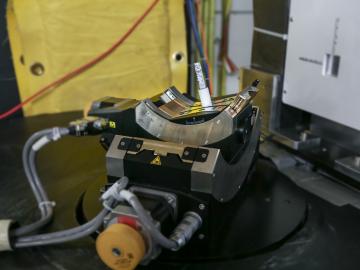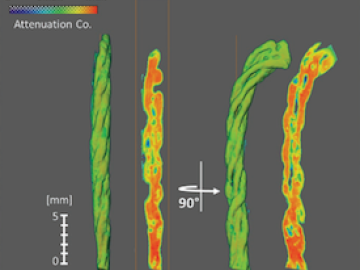
Filter News
Area of Research
- (-) Advanced Manufacturing (8)
- (-) Neutron Science (129)
- (-) Nuclear Science and Technology (7)
- Biology and Environment (59)
- Building Technologies (2)
- Computational Biology (1)
- Computational Engineering (3)
- Computer Science (16)
- Electricity and Smart Grid (1)
- Energy Science (108)
- Energy Sciences (1)
- Functional Materials for Energy (1)
- Fusion and Fission (8)
- Fusion Energy (2)
- Isotopes (1)
- Materials (73)
- Materials for Computing (16)
- Mathematics (1)
- National Security (34)
- Quantum information Science (7)
- Supercomputing (138)
News Topics
- (-) Artificial Intelligence (7)
- (-) Computer Science (16)
- (-) Frontier (1)
- (-) Machine Learning (4)
- (-) Neutron Science (122)
- (-) Polymers (1)
- 3-D Printing/Advanced Manufacturing (29)
- Advanced Reactors (12)
- Big Data (2)
- Bioenergy (9)
- Biology (7)
- Biomedical (16)
- Biotechnology (1)
- Chemical Sciences (3)
- Clean Water (2)
- Composites (4)
- Coronavirus (11)
- Cybersecurity (3)
- Energy Storage (6)
- Environment (8)
- Fossil Energy (1)
- Fusion (10)
- High-Performance Computing (2)
- Hydropower (1)
- Isotopes (5)
- Materials (18)
- Materials Science (30)
- Mathematics (1)
- Microscopy (3)
- Molten Salt (4)
- Nanotechnology (10)
- National Security (2)
- Nuclear Energy (39)
- Physics (10)
- Quantum Computing (1)
- Quantum Science (7)
- Security (2)
- Space Exploration (9)
- Summit (6)
- Transportation (5)
Media Contacts

While studying how bio-inspired materials might inform the design of next-generation computers, scientists at ORNL achieved a first-of-its-kind result that could have big implications for both edge computing and human health.

Neutron scattering techniques were used as part of a study of a novel nanoreactor material that grows crystalline hydrogen clathrates, or HCs, capable of storing hydrogen.

Oak Ridge National Laboratory researchers are developing a first-of-its-kind artificial intelligence device for neutron scattering called Hyperspectral Computed Tomography, or HyperCT.

Scientists at ORNL used neutron scattering to determine whether a specific material’s atomic structure could host a novel state of matter called a spiral spin liquid.

Oak Ridge National Laboratory’s Innovation Crossroads program welcomes six new science and technology innovators from across the United States to the sixth cohort.

To solve a long-standing puzzle about how long a neutron can “live” outside an atomic nucleus, physicists entertained a wild but testable theory positing the existence of a right-handed version of our left-handed universe.

ORNL researchers used the nation’s fastest supercomputer to map the molecular vibrations of an important but little-studied uranium compound produced during the nuclear fuel cycle for results that could lead to a cleaner, safer world.

From helping 750 million viewers watch Princess Diana’s wedding to enabling individual neutron scientists observe subatomic events, Graeme Murdoch has helped engineer some of the world’s grandest sights and most exciting scientific discoveries.

Textile engineering researchers from North Carolina State University used neutrons at Oak Ridge National Laboratory to identify a special wicking mechanism in a type of cotton yarn that allows the fibers to control the flow of liquid across certain strands.

More than 50 current employees and recent retirees from ORNL received Department of Energy Secretary’s Honor Awards from Secretary Jennifer Granholm in January as part of project teams spanning the national laboratory system. The annual awards recognized 21 teams and three individuals for service and contributions to DOE’s mission and to the benefit of the nation.


